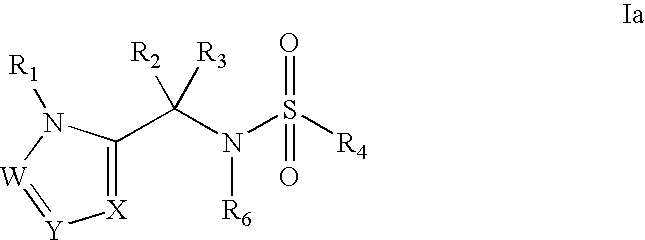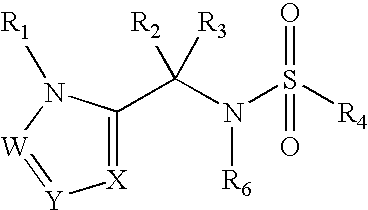Heterocyclic sulfonamide inhibtors of beta amyloid production containing an azole
a technology of heterocyclic sulfonamide and beta amyloid, which is applied in the direction of biocide, drug composition, extracellular fluid disorder, etc., can solve the problems of toxic aggregated beta amyloid in cell culture, detrimental to memory, etc., and achieve the effect of inhibiting beta amyloid production and elevated beta amyloid protein levels
- Summary
- Abstract
- Description
- Claims
- Application Information
AI Technical Summary
Benefits of technology
Problems solved by technology
Method used
Image
Examples
example 1
5-Chloro-N-{2-ethyl-1-[1-(4-methoxybenzyl)-1H-pyrazol-5-yl]butyl}thiophene-2-sulfonamide
A. 2-Ethyl-1-[1-(4-methoxybenzyl)- H-pyrazol-5-yl]butan-1-ol
[0068] To 1-(4-methoxybenzyl)-1H-pyrazole (Synthetic Comm. 25(5), 761-774 (1995)) (2.43 g, 12.9 mmol) in THF (100 mL) at −78° C. was added a solution of n-BuLi (2 M in cyclohexane, 7.1 mL, 14.2 mmol) dropwise. After 75 min, 2-ethylbutyraldehyde (1.3 mL, 10.6 mmol) was added. After 45 min the reaction mixture was quenched with saturated aqueous ammonium chloride (50 mL), extracted with EtOAc (3×100 mL), dried (Na2SO4) and concentrated. Column chromatography (EtOAc / hexanes, 1:4) provided 1.37 g (37%) of 2-ethyl-1-[1-(4-methoxybenzyl)-1H-pyrazol-5-yl]butan-1-ol as an oil.
[0069]1H NMR (400 MHz, DMSO-d6): δ 0.66 (t, 3H, J=7.4 Hz), 0.73 (t, 3H, J=7.4 Hz), 1.01-1.12 (m, 2H), 1.29-1.50 (m, 3H), 3.70 (s, 3H), 4.51 (t, 1H, J=6.5 Hz), 5.21 (d, 1H, J=5.7 Hz), 5.26 (d, 2H, J=3.5 Hz), 6.15 (d, 1H, J=1.5 Hz), 6.85 (d, 2H, J=8.6 Hz), 7.06 (d, 2H, J=8...
example 2
4-Chloro-N-{2-ethyl-1-[1-(4-methoxybenzyl)-1H-pyrazol-5-yl]butyl}benzenesulfonamide
[0080] The compound of example 2 was synthesized from {2-ethyl-1-[1-(4-methoxybenzyl)-1H-pyrazol-5-yl]butyl}amine in a manner similar to that of example 1 but using 4-chlorobenzenesulfonyl chloride as the sulfonyl chloride in step 1 D. The product was isolated as white foam in 52% yield.
[0081]1H NMR (400 MHz, DMSO-d6): δ 0.61 (t, 3H, J=7.4 Hz), 0.65 (t, 3H, J=7.3 Hz), 0.84-0.99 (m, 2H), 1.17-1.36 (m, 3H), 3.71 (s, 3H), 4.39 (m, 1H), 5.09 (q, 2H, J=15.7 Hz), 6.00 (d, 1H, J=1.5 Hz), 6.87 (d, 2H, J=8.6 Hz), 6.99 (d, 2H, J=8.6 Hz), 7.13 (d, 1H, J=1.4 Hz), 7.39 (s, 4H), 8.20 (br s, 1H); Mass Spectrum (+ESI): 462 (M+H)+.
[0082] Anal: Calc'd for C23H28ClN3O3S2, C, 59.79; H, 6.11; N, 9.10.
[0083] Found: C, 59.69; H, 5.89; N, 8.95.
example 3
4-Bromo-N-{2-ethyl-1-[1-(4-methoxybenzyl)-1H-pyrazol-5-yl]butyl}benzenesulfonamide
[0084] The compound of example 3 was synthesized from {2-ethyl-1-[1-(4-methoxybenzyl)-1H-pyrazol-5-yl]butyl}amine in a manner similar to that of example 1 but using 4-bromobenzenesulfonyl chloride as the sulfonyl chloride in step 1D. The product was isolated as a white foam in 67% yield.
[0085]1H NMR (400 MHz, DMSO-d6): δ 0.61 (t, 3H, J=7.3 Hz), 0.65 (t, 3H, J=7.3 Hz), 0.84-0.99 (m, 2H), 1.17-1.36 (m, 3H), 3.72 (s, 3H), 4.40 (t, 1H, J=7.5 Hz), 5.05 (q, 2H, J=15.7 Hz), 6.01 (d, 1H, J=1.5 Hz), 6.87 (d, 2H, J=8.6 Hz), 6.99 (d, 2H, J=8.6 Hz), 7.14 (d, 1H, J=1.7 Hz), 7.32 (d, 2H, J=8.4 Hz), 7.53 (d, 2H, J=8.4 Hz), 8.21 (d, 1H, 8.9 Hz); Mass Spectrum (+ESI): 506 (M+H)+.
[0086] Anal: Calc'd for C23H28BrN3O3S2 C, 54.55; H, 5.57; N, 8.30.
[0087] Found: C, 54.73; H, 5.56; N, 8.21.
PUM
| Property | Measurement | Unit |
|---|---|---|
| temperature | aaaaa | aaaaa |
| flow rate | aaaaa | aaaaa |
| total volume | aaaaa | aaaaa |
Abstract
Description
Claims
Application Information
 Login to View More
Login to View More - R&D
- Intellectual Property
- Life Sciences
- Materials
- Tech Scout
- Unparalleled Data Quality
- Higher Quality Content
- 60% Fewer Hallucinations
Browse by: Latest US Patents, China's latest patents, Technical Efficacy Thesaurus, Application Domain, Technology Topic, Popular Technical Reports.
© 2025 PatSnap. All rights reserved.Legal|Privacy policy|Modern Slavery Act Transparency Statement|Sitemap|About US| Contact US: help@patsnap.com



